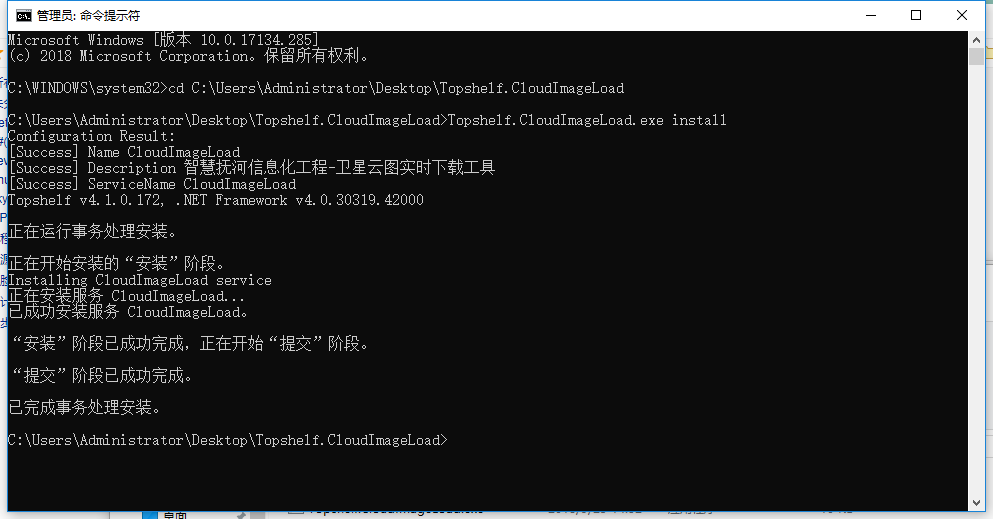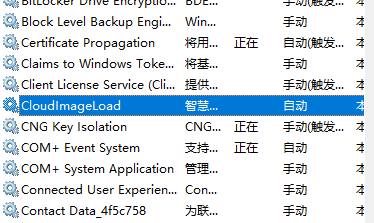Preface:
I wrote an earlier article "Creating windows Services with C_#", https://www.cnblogs.com/huangwei1992/p/9693167.html, and then a blogger recommended an open source framework Topshelf to me.
Writing a bit of test code, I found that the Topshell framework is really very useful in creating windows services, so I modified my previous code.
Development process:
1. Without using the Topshell framework, we need to create a Windows service program, where we just need to create a console program.
2. Adding references
Use the Program Installation Command:
- Install-Package Topshelf
Search Topshelf directly in NuGet Package Manager and click Installation:

3. New core class CloudImage Manager
There are three main methods: LoadCloudImage, Start, Stop, and paste code directly.
/// <summary>
/// Function Description: Satellite Cloud Map Download Manager
/// Creator: Administrator
/// Creation date: 2018/9/25 14:29:03
/// Last Modifier: Administrator
/// Date of final revision: 2018/9/25 14:29:03
/// </summary>
public class CloudImageManager
{
private string _ImagePath = System.Configuration.ConfigurationManager.AppSettings["Path"];
private Timer _Timer = null;
private double Interval = double.Parse(System.Configuration.ConfigurationManager.AppSettings["Minutes"]);
public CloudImageManager()
{
_Timer = new Timer();
_Timer.Interval = Interval * 60 * 1000;
_Timer.Elapsed += _Timer_Elapsed;
}
void _Timer_Elapsed(object sender, ElapsedEventArgs e)
{
StartLoad();
}
/// <summary>
/// Start downloading clouds
/// </summary>
private void StartLoad()
{
LoadCloudImage();
}
public void Start()
{
StartLoad();
_Timer.Start();
}
public void Stop()
{
_Timer.Stop();
}
/// <summary>
/// Download all satellite images of the day
/// </summary>
private void LoadCloudImage()
{
CreateFilePath();//Determine whether a folder exists or not, and create it if it does not exist
//Get the previous day's date
string lastYear = DateTime.Now.AddDays(-1).Year.ToString();
string lastMonth = DateTime.Now.AddDays(-1).Month.ToString();
if (lastMonth.Length < 2) lastMonth = "0" + lastMonth;
string lastDay = DateTime.Now.AddDays(-1).Day.ToString();
if (lastDay.Length < 2) lastDay = "0" + lastDay;
//Get the date of the day
string year = DateTime.Now.Year.ToString();
string month = DateTime.Now.Month.ToString();
if (month.Length < 2) month = "0" + month;
string day = DateTime.Now.Day.ToString();
if (day.Length < 2) day = "0" + day;
//Set all filenames
string[] dates0 = { lastYear + "/" + lastMonth + "/" + lastDay, year + "/" + month + "/" + day };
string[] dates = { lastYear + lastMonth + lastDay, year + month + day };
string[] hours = { "00", "01", "02", "03", "04", "05", "06", "07", "08", "09", "10", "11", "12", "13", "14", "15", "16", "17", "18", "19", "20", "21", "22", "23" };
string[] minutes = { "15", "45" };
int hLength = hours.Count();
//Traverse all online clouds on the day of download
for (int i = 0; i < 2; i++)
{
string date = dates[i];
string date0 = dates0[i];
for (int j = 0; j < hLength; j++)
{
string hour = hours[j];
for (int k = 0; k < 2; k++)
{
string minute = minutes[k];
string imageUrl = @"http://image.nmc.cn/product/" + date0 + @"/WXCL/SEVP_NSMC_WXCL_ASC_E99_ACHN_LNO_PY_" + date + hour + minute + "00000.JPG";
string[] s = imageUrl.Split('/');
string imageName = s[s.Count() - 1];
HttpWebRequest request = HttpWebRequest.Create(imageUrl) as HttpWebRequest;
HttpWebResponse response = null;
try
{
response = request.GetResponse() as HttpWebResponse;
}
catch (Exception)
{
continue;
}
if (response.StatusCode != HttpStatusCode.OK) continue;
Stream reader = response.GetResponseStream();
FileStream writer = new FileStream(_ImagePath + imageName, FileMode.OpenOrCreate, FileAccess.Write);
byte[] buff = new byte[512];
int c = 0; //Number of bytes actually read
while ((c = reader.Read(buff, 0, buff.Length)) > 0)
{
writer.Write(buff, 0, c);
}
writer.Close();
writer.Dispose();
reader.Close();
reader.Dispose();
response.Close();
}
}
}
}
/// <summary>
/// Determine whether a folder exists or not, and create it if it does not exist
/// </summary>
private void CreateFilePath()
{
if (Directory.Exists(_ImagePath))
{
ClearImages();
return;
}
else
{
Directory.CreateDirectory(_ImagePath);
}
}
/// <summary>
/// Clear all files under folders
/// </summary>
private void ClearImages()
{
try
{
DirectoryInfo dir = new DirectoryInfo(_ImagePath);
FileSystemInfo[] fileinfo = dir.GetFileSystemInfos(); //Returns all files and subdirectories in the directory
foreach (FileSystemInfo i in fileinfo)
{
if (i is DirectoryInfo) //Determine whether a folder or not
{
DirectoryInfo subdir = new DirectoryInfo(i.FullName);
subdir.Delete(true); //Delete subdirectories and files
}
else
{
File.Delete(i.FullName); //Delete the specified file
}
}
}
catch (Exception e)
{
Console.WriteLine(e.Message);
}
}
}
Then call in Program.cs:
static void Main(string[] args)
{
HostFactory.Run(x => //1
{
x.Service<CloudImageManager>(s => //2
{
s.ConstructUsing(name => new CloudImageManager()); //3
s.WhenStarted(tc => tc.Start()); //4
s.WhenStopped(tc => tc.Stop()); //5
});
x.RunAsLocalSystem(); //6
x.SetDescription("Real-time download tool for satellite cloud images"); //7
x.SetDisplayName("CloudImageLoad"); //8
x.SetServiceName("CloudImageLoad"); //9
});
}
As you can see, the calls mainly involve constructors, Start methods, and Stop methods in the CloudImageManager class.
Installation, operation and unloading:
These operations for services under the Topshell framework are relatively simple

